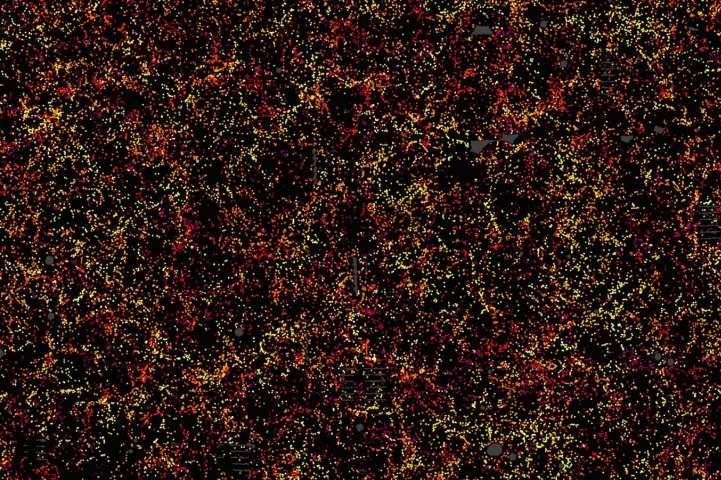A small sliver of the 3D map of the distant universe. Each dot represents a galaxy six billion years into the past. The color indicates the galaxy's distance from Earth. Photo by Daniel Eisenstein/SDSS-III
PORTSMOUTH, England, July 14 (UPI) -- Dark energy -- the mysterious force responsible for the expansion of the universe -- remains elusive, but researchers hope a new 3D map of distant galaxies will help them finally measure it.
"This extremely detailed three-dimensional map represents a colossal amount of work," lead researcher Florian Beutler, a scientists at the University of Portsmouth's Institute of Cosmology and Gravitation, explained in a news release.
It's the largest 3D map of its kind.
"The University of Portsmouth has worked with partner institutions for ten years, helping to gather measurements of galaxies making up a quarter of the sky," Beutler said. "Using this map we will now be able to make the most accurate possible measurements of dark energy, and the part it plays in the expansion of the universe."
The map relies on new measurements by the Baryon Oscillation Spectroscopic Survey program, part of the Sloan Digital Sky Survey II.
By measuring the size of baryonic acoustic oscillations within the three-dimensional structure of faraway galaxies, astronomers can more accurately calculate the expansion rate of the universe.
Baryonic acoustic oscillations are fluctuations or anomalies in the distribution of matter in the universe.
These fluctuations are revealed in the sound waves that traveled through the early universe but became frozen in matter some 400,000 years after the Big Bang. Measuring the size of these pressure wave signatures can reveal the push-and-pull effects of dark matter and dark energy on the rest of the cosmos.
Models of the evolution of the universe suggest dark matter began driving the expansion of the universe some 5 billion years ago. Baryon Oscillation Spectroscopic Survey program is designed to focus on sound wave fluctuations between 7 billion and 2 billion years ago.
If that is truly the case, scientists say their latest calculations prove the influence of dark energy on the expansion of the universe is weak. In other words, the sound wave signatures haven't changed much.
"We see a dramatic connection between the sound wave imprints seen in the cosmic microwave background 400,000 years after the Big Bang to the clustering of galaxies 7 to 12 billion years later," said Rita Tojeiro, an astronomer the University of St. Andrews. "The ability to observe a single well-modeled physical effect from recombination until today is a great boon for cosmology."
Researchers recently submitted a series of papers describing the map's construction to the Monthly Notices of the Royal Astronomical Society.
"BOSS has marked an important cosmological milestone, combining precise clustering measurements of an enormous volume with extensive observations of the primary cosmic microwave background to produce a firm platform for the search for extensions to the standard cosmological model," concluded Jeremy Tinker, a cosmologist at New York University. "We look forward to seeing this program extended with the coming decade of large spectroscopic surveys."















